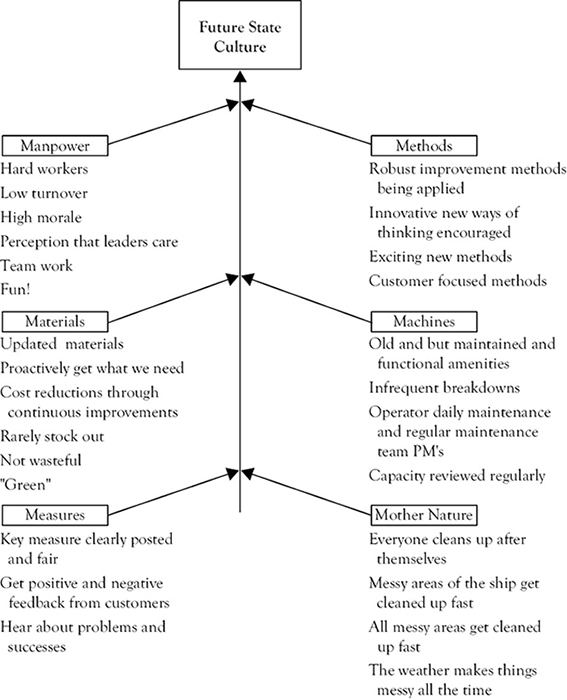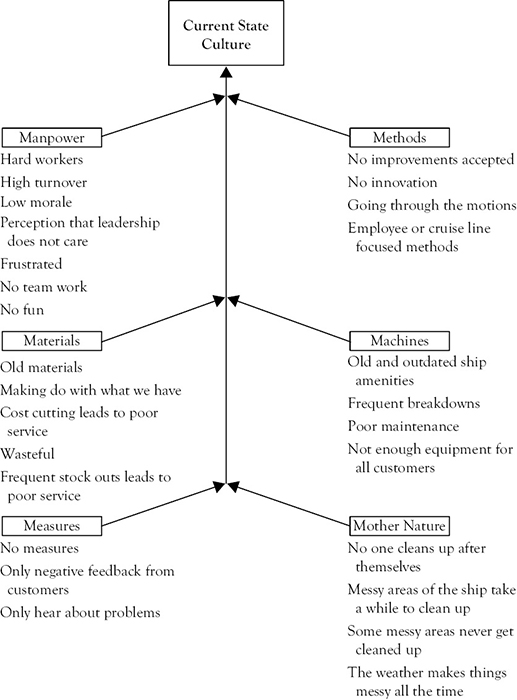Making Sales Cultural Transitions
Bill and his sales team had made great progress. There had been many ups and downs during the improvement initiatives, but overall the teams were really making a positive impact. The teams were getting good at identifying current state data, developing process flow, and value stream maps, and then creating future state plan, do check, act (PDCA) experiments to try to make improvements. However, there were still some areas that Bill was wondering about. For example, Bill was concerned about the people side of the improvement initiatives. Some of the people-side issues Bill was concerned about were training to sustain the gains and momentum, the discipline to stick to the standard work, and the accountability. Managing sales people had sometimes been compared to herding cats!
In the early days of the transformation Sam had Bill work with his people to develop a current state culture assessment. To do this Bill lead a brainstorming session with his sales team, and developed the following current state culture diagram.
This map is in a cause and effect format, and it shows clearly the problems and potential target improvement areas. Teams can use this or similar methods to document their current culture and target areas for improvement. With this completed, Bill thought it would be a good idea to lead the sales team through the future state culture development to show what they wanted to become. They called this the future state culture, and used it as a vision for them to achieve through the continuous improvement efforts. The following future state culture map was developed by Bill’s sales team. They all agreed to try to live up to the vision. The implementation of the improvement teams went a long way toward helping the teams achieve the future state culture.


Sam had assisted Bill with this current state to future state culture mapping process to help Bill’s sales team understand where they were going and what they were trying to become with the Lean Sigma improvement methods.
Sam was most impressed with some of the sales training that Bill had developed, and thought he might be able to use it in the supply chain area. “So Bill, tell me about your sales training program, your people are clearly doing something different than my folks are with the supply chain. Your people are constantly interacting with customers, and I can tell they’ve had some specific training regarding how to talk and listen to customers, so what is it?” Sam asked Bill.
Bill said, “Let’s go talk with our HR manager, Ann, she’s the one who developed the program.” The two took a walk to the HR offices to meet with Ann.
At the HR offices Ann outlined their customer service and sales training programs. Ann explained, “I’ve studied the Disney training programs and had the opportunity to attend several courses at the highly regarded Disney Institute. The Disney Institute is widely recognized as a world leader in service training and development. I’m taking a page from the Walt Disney Company where they call all of their employee’s cast members. A cast member has a different meaning than an employee. A cast member has to be able to play a role. The cast member’s role may be a sales person or customer service person. In any case, a cast member is expected to act in an appropriate way, to play their role as though they are at the happiest place on earth!”
Ann continued, “We are trying to instill this philosophy at Rapid Products. To do this, I use six key training classes. Every new sales or customer service employee receives the following courses over their first three months of being hired.” Our programs are as follows:
Basic Training Programs
• Orientation
• Lean Sigma Basics: Ptacek and Motwani.
• The Seven Habits of Highly Effective People: Steven Covey.
• Developing Customer Loyalty: Jeffrey Gitomer.
• FISH! Philosophy: Stephen C. Lundin, PhD, Harry Paul, John Christensen.
• Counselor selling
The orientation was not unlike any organization’s orientation training. This course introduced the new employees to the organization and covered the following topics.
a. General orientation and facts about the cruise line
b. Vision, mission, and values
c. Organization structure
d. Key performance indicators (KPIs)
e. Performance expectations
f. Safety rules
“Since the organization was making so much progress with the Lean Sigma methods and tools, we recently updated the key training programs to include the basics of Lean Sigma. Now the new employees knew what was expected of them regarding continuous improvement, and how they could participate. I recruit various area leaders to facilitate this training,” continued Ann.
The seven habits training covered the following seven habits from the popular book by Steven Covey.
1. Be proactive
2. Begin with the end in mind
3. Put first things first
4. Think win-win
5. Seek first to understand, then to be understood
6. Synergize
7. Sharpen the saw (continue learning and teaching)
The objective of this training was to help people develop a success habit for their personal and professional lives. These habits were described as expected behaviors of employees and were reviewed during their performance appraisals.
The developing customer loyalty training was used to help employees more effectively help internal and external customers no matter what the need. This training taught specific skills, tools, and techniques. Practice time was provided in class so people could develop their skills. One of the key concepts taught was that we want loyal customers who come back time and time again, and refer our cruise line to other people. One critical technique taught in class is the 3 Rs +1. This technique teaches cast members how to respond to customers who need help. When a customer asks for assistance, employees are expected to do the following;
• React to the situation and customer emotion with certain phrases in a sincere manner.
• Respond to the need in an appropriate manner to develop customer loyalty as they would want it responded to.
• Resolve the issue to the customers satisfaction: How they would want the situation resolved it if they were the customer.
• 1 Do one extra thing for the customer that is not expected, but welcomed.
“This is a simple and powerful technique if done properly,” Ann continued.
“We use the FISH! Philosophy video, which highlights the operations and philosophy of the Pike’s Fish Market in Seattle, Washington, to instill a sense of service and fun in each employee. The video illustrates the power of four simple principles of customer service and dealing with people.” The FISH philosophies are as follows:
1. Play
2. Be there
3. Make their day
4. Choose your attitude
The “play” principle shows people how to make work fun for the customer and the worker. Several specific methods are developed during the training. The “be there” principle helps employees connect with customers and people in a more meaningful way. It helps people be more sincere in their efforts to help people. “Make their day” helps people to understand what it takes to develop customer loyalty, and is complimentary of the customer loyalty training. It gives everyone additional ideas on how to develop customer loyalty and future referrals. Finally, the “choose your attitude” training delivers the message that she expects every employee to be the best every day, and only they can choose their attitude. This fits well with the “Seven Habits” training on being proactive, as well as many other habits.
The counselor selling program is where we teach our sales people to be counselors to our customers, not just sales people. Their goal is to solve problems for our customers whether it is our service or not that is the solution. If customers see our sales people keeping their best interest in mind, they will call us time and time again to allow us to help solve their problems. It is our hope that eventually our services will develop to serve their needs. At a minimum, customers will develop a high level of trust and team work with Rapid Products.
“The training doesn’t stop there.” Ann explained, “Every employee continues to receive refresher training on these topics on a regular basis. This supports the culture future state targets. It all fits together, and we’re making such huge improvements in retention and customer feedback.”
After listening to Ann’s passion about this training, Sam asked Bill and Ann if they would consider delivering some of this training to his supply chain team. After the help Sam had provided to Bill and the slumping sales team, Bill quickly agreed to help Sam, and the two began developing the cross-organizational training plan.
Discussion Questions
1. What do you think of Bill’s concerns regarding the people side of the improvement initiatives? Do you encounter the same concerns in your organization? How does your organization and you deal with them?
2. What do you think of the process used by Bill to address these concerns? Do you think it was a good idea to do a current state and future state cultural assessment? Why or why not? What lessons can your organization learn from this process?
3. Critically evaluate the sales, customer service, and loyalty training programs that Bill and Ann have developed. Do you think these programs are appropriate?
